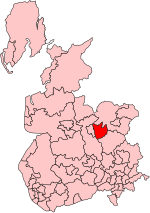| Accrington | |
|---|---|
| Former borough constituency for the House of Commons | |
 Accrington in Lancashire, showing boundaries used from 1974–1983 | |
| County | Lancashire |
| Borough | Accrington |
| 1918–1983 | |
| Seats | 1 |
| Replaced by | Hyndburn |
| 1885–1918 | |
| Seats | 1 |
| Type of constituency | County constituency |
| Created from | North East Lancashire |
Accrington was a parliamentary constituency of the House of Commons of the Parliament of the United Kingdom from 1885 to 1983. It elected one Member of Parliament (MP) by the first-past-the-post system of election.
Contents
- History
- Boundaries
- 1885–1918
- 1918–1950
- 1950–1983
- Abolition
- Members of Parliament
- Elections
- Elections in the 1880s
- Elections in the 1890s
- Elections in the 1900s
- Elections in the 1910s
- Elections in the 1920s
- Elections in the 1930s
- Elections in the 1940s
- Elections in the 1950s
- Elections in the 1960s
- Elections in the 1970s
- References and notes
- Sources


